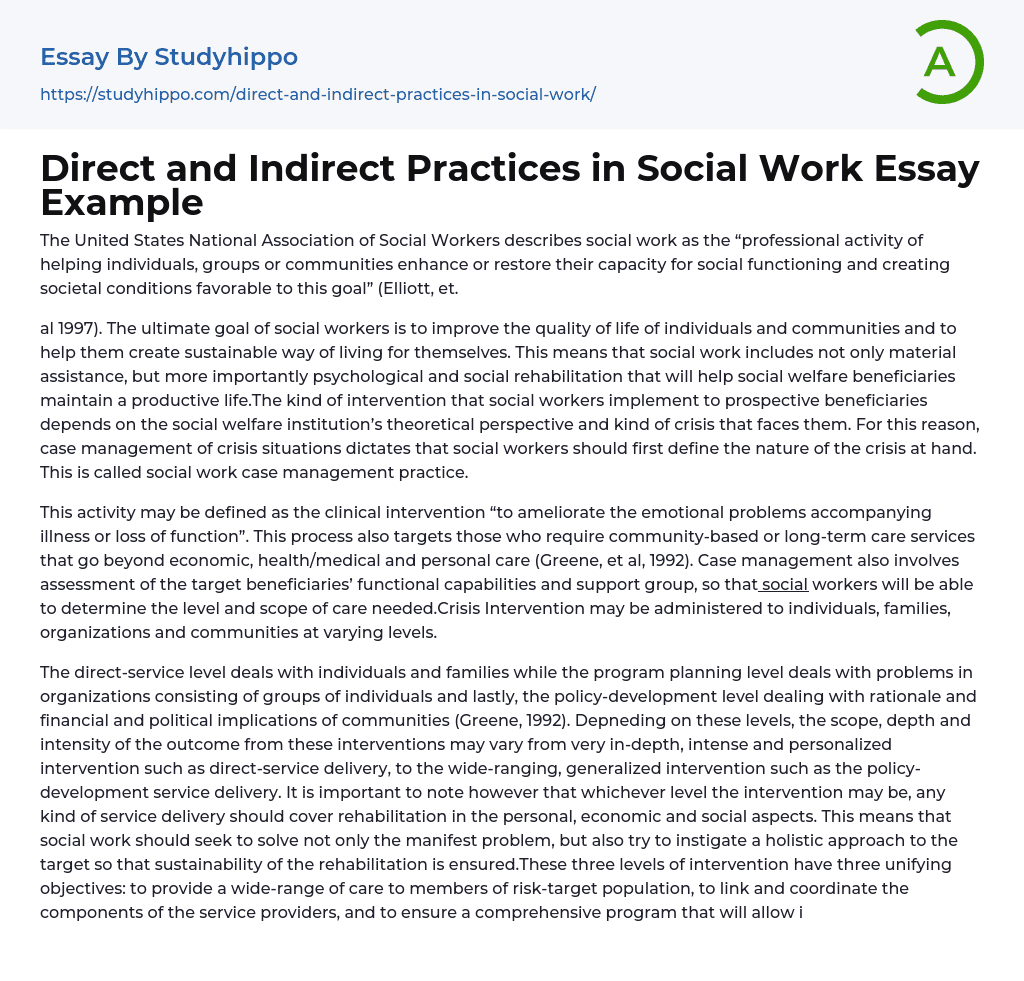

Direct and Indirect Practices in Social Work Essay Example
The United States National Association of Social Workers describes social work as the “professional activity of helping individuals, groups or communities enhance or restore their capacity for social functioning and creating societal conditions favorable to this goal” (Elliott, et.
al 1997). The ultimate goal of social workers is to improve the quality of life of individuals and communities and to help them create sustainable way of living for themselves. This means that social work includes not only material assistance, but more importantly psychological and social rehabilitation that will help social welfare beneficiaries maintain a productive life.The kind of intervention that social workers implement to prospective beneficiaries depends on the social welfare institution’s theoretical perspective and kind of crisis that faces them. For this reason, case management of crisis situations dictates that social workers should first define the nature of the crisis at hand. This is called soci
...al work case management practice.
This activity may be defined as the clinical intervention “to ameliorate the emotional problems accompanying illness or loss of function”. This process also targets those who require community-based or long-term care services that go beyond economic, health/medical and personal care (Greene, et al, 1992). Case management also involves assessment of the target beneficiaries’ functional capabilities and support group, so that social workers will be able to determine the level and scope of care needed.Crisis Intervention may be administered to individuals, families, organizations and communities at varying levels.
The direct-service level deals with individuals and families while the program planning level deals with problems in organizations consisting of groups of individuals and lastly, the policy-development level dealing with rationale and financial and political implication
of communities (Greene, 1992). Depneding on these levels, the scope, depth and intensity of the outcome from these interventions may vary from very in-depth, intense and personalized intervention such as direct-service delivery, to the wide-ranging, generalized intervention such as the policy-development service delivery. It is important to note however that whichever level the intervention may be, any kind of service delivery should cover rehabilitation in the personal, economic and social aspects. This means that social work should seek to solve not only the manifest problem, but also try to instigate a holistic approach to the target so that sustainability of the rehabilitation is ensured.These three levels of intervention have three unifying objectives: to provide a wide-range of care to members of risk-target population, to link and coordinate the components of the service providers, and to ensure a comprehensive program that will allow individuals to meet their full potential (Greene, 1992).
With these concepts as point of reference, social workers undertake the eight major functions of crisis case management (Greene, 1992). First, social workers identify and establish contacts with the target population to demarcate those who need specific needs at specific levels. One of the challenges in this stage is the fear of disclosure of target population and the effective establishment of rapport with them. The second step is individual and family assessment and diagnosis which includes determination of target’s needs, motivations, strengths, weaknesses and capacity to clearly define the problem at hand so that social workers will be guided on that they still need and which life aspects to improve on. The third case management function is to plan for services and the resources to be
given to the target.
Fourth stage is to link the target to the services needed, wherein social workers make sure that services may be delivered without barriers from the providers to the target population (Greene, 1992).Fifth function is the actual implementation and coordination of services. This process ensures the harmonious and coordinated flow of services for the continuity of the intervention. The sixth function is the monitoring of the service delivery, wherein the social worker gathers feedback from the target population on how they assess the social worker’s service delivery implementation and coordination. This will serve as the workers’ guide on which aspects to improve on. Advocacy is the seventh function of case management which involves speaking in behalf of the target to encourage more supporters of the intervention and/or project, convincing other people that the problem or condition of the target has also has effects on the others.
The last stage of the case management practice is evaluation, wherein the social workers become aware of their accountability to the target, to the funding source and to the policymakers. This is the stage where they assess their performance as service coordinators. This assessment may be based on the actions that has been taken to resolve the problem or also on the comparison of the condition of the target population before, during and after the intervention (Greene, 1992). The results of the evaluation may then become a basis for future case management and project implementation practices.
- Anatomy and Physiology essays
- Addiction essays
- Biodegradation essays
- Dental Care essays
- Disease essays
- Disorders essays
- Health Care essays
- Intelligence Quotient essays
- Nutrition essays
- Olfaction essays
- Public Health essays
- Women's Health essays
- World health organization essays
- Cancer essays
- Infectious Disease essays
- Lung Cancer essays
- Neurology essays
- Physical Exercise essays
- Medicine essays
- Sex essays
- Inquiry essays
- Disability essays
- Poison essays
- Action Potential essays
- Nervous System essays
- Childbirth essays
- Puberty essays
- Blood essays
- Kidney essays
- Neuron essays
- Body essays
- Glucose essays
- Sense essays
- Heart essays
- Skeleton essays
- Human Physiology essays
- Eye essays
- Immune System essays
- Muscle essays
- Skin essays
- Brain essays
- Central Nervous System essays
- Human Skin Color essays
- Digestive System essays
- Common sense essays
- Respiration essays
- alcoholism essays
- Smoking essays
- Casino essays
- Tobacco essays



